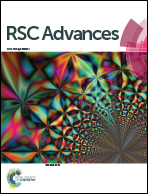1-Butylimidazole-derived ionic liquids: synthesis, characterisation and evaluation of their antibacterial, antifungal and anticancer activities†
Abstract
A series of new 1-butylimidazole-based ionic liquids (3a–h) have been synthesised by the quaternisation reaction of 1-butylimidazole with different alkyl- and alkoxy-substituted aryl halides using a microwave solvent-free approach with ≈82–95% yield. The solvent-free approach allows the preparation of a variety of ILs with better yields and purities, making any further purification unnecessary. The structures were confirmed by FTIR, 1H NMR, 13C NMR and LCMS (Q-TOF). The ILs were screened against Gram-positive (S. aureus and B. subtilis) and Gram-negative (E. coli and P. aeruginosa) bacterial strains. Compounds 3b, 3c, 3e and 3f showed good activities against both S. aureus and B. subtilis strains, while 3a and 3c exhibited good activities against P. aeruginosa strains. The ILs 3a, 3b, 3d and 3e showed better antifungal activities against the C. albicans strain. Additionally, the compounds were tested for their in vitro anticancer activities against the MCF-7 and MDA-MB-435 cell lines using an SRB assay protocol to estimate cell growth. Compounds 3a, 3d and 3e demonstrated 50–60% activity against the MDA-MB-435 cell line with GI50 values of 67.2, 52.5 and 57.9 μM, respectively, as compared to standard adriamycin (GI50 24.4 μM).


 Please wait while we load your content...
Please wait while we load your content...